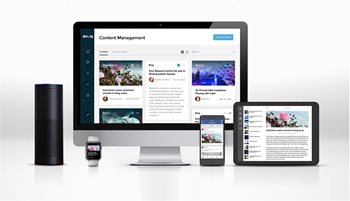DNN's Liquid Content Enables Omnichannel Content Publishing
Late last year, DNN Software, enterprise content management system provider, announced the general availability of Evoq 9 including its Content-as-a-Service platform (CaaS), Liquid Content that allows content to be published beyond a website to apps, channels, and Internet of Things (IoT) devices. At that time, DNN stressed how the Liquid Content speaks directly to what they believe is the future of content management. With that momentum, San Mateo, Calif.-based solution provider didn’t rest on its laurels, and today, they announced the general availability of Evoq 9.1. With the new release, Liquid Content can seamlessly publish to devices like Amazon Echo, and applications like Facebook Messenger, Facebook, Twitter and LinkedIn.
To find out more about this new release, our media reporter Laura Myers reached out to Will Morgenweck, Vice President of Product Management at DNN, and they dove into the details of the new capabilities:
During the interview, Morgenweck divided the multichannel publishing into three main stages; Content curation, pushing the content through the REST API, and analytics. With new features, whether you create content for your website or for a mobile app, it is all in one location and now it is really easy for users to push that content out right from the application to all the preferred channels and devices. Morgenweck also explained to us what is cool about this new release: “You can start to create content and that content doesn’t have to exist anywhere yet so you can just create and store it in the system. From there, you can us the REST API to pull that content out or push it out to other channels such as mobile apps, Apple TV, kiosks, or Alexa.”
You created the content and push that out to the channels and devices that your organization is on, now what? It is time to find out how your content is performing, how your audience is interacting with it, and which channel is working out as well as which is not. Monitoring all these is easy when you have one simple piece of content published on only your website, but how about when you publish that piece of content across all those other social media channels and devices? That’s where Liquid Content comes into play. With the Liquid Content features delivered as a microservice via DNN’s Liquid Content Cloud, users can get analytics insights for each channel from one single analytics source, instead of gathering and mostly duplicating all the data separately from different platforms.
Check the Day’s Specials by Asking Alexa
Here at CMS-Connected, one of the topics we covered the most is how technologies powered by artificial intelligence and machine learning are shaping the future of businesses. A 451 Research survey, for instance, disclosed that 71% of enterprises are gathering data for IoT initiatives today. So it is no secret that organizations should really rethink how value is being created for your customers in the light of this new trend. As being a forward-thinking vendor, DNN, made Liquid Content seamlessly integrates with devices. As an example of this capability, they developed a new Alexa Skill for the Amazon Echo. The Alexa Skill accesses content stored in Liquid Content through Liquid Content’s REST API. As a result, the semantically tagged content enables Alexa to provide answers to questions.
by artificial intelligence and machine learning are shaping the future of businesses. A 451 Research survey, for instance, disclosed that 71% of enterprises are gathering data for IoT initiatives today. So it is no secret that organizations should really rethink how value is being created for your customers in the light of this new trend. As being a forward-thinking vendor, DNN, made Liquid Content seamlessly integrates with devices. As an example of this capability, they developed a new Alexa Skill for the Amazon Echo. The Alexa Skill accesses content stored in Liquid Content through Liquid Content’s REST API. As a result, the semantically tagged content enables Alexa to provide answers to questions.
“A restaurant can use Liquid Content to connect with its hard-to-reach customers; not only can menu items be published to its website and social channels, but customers can check the day’s specials by asking Alexa,” said Navin Nagiah, CEO of DNN Software.
During the interview with Morgenweck, he also explained the primary motivation behind the development of the Alexa Skill: “When we’ve started to work with our own API, we tried to think of the cool ways that people are going to be interacting with content more in the near future. And, of course, we came up with Alexa, Google Home, Microsoft Cortana, and Apple Sri, these are all ways that people are interacting with content by using their voice.” Then, they picked Alexa to demonstrate how the platform can store that content in a written form and then allow users to transform it to the other channels, so when they query information, they get their answers back.
The platform provides a stateless API that allows users to access and retrieve content and delivery of services through DNN's Liquid Content Cloud, powered by Microsoft Azure. And that is really where the content publishing is heading to. In fact, in Forrester’s report entitled The Rise of the Headless Content Management System, analysts Ted Schadler and Mark Grannan predicted: “Even if web CMS or eCommerce vendors are not going to relinquish control of the presentation layer to a dynamic JavaScript framework like Angular, they will be forced to publish new stateless APIs to deliver content everywhere. Doing this properly will take the vendors years and cost millions or tens of millions of development dollars.”
Marketers Will Maximize the Value of Content
When Evoq 9 first released, I had reached out to Joe Brinkman, Co-Founder, VP of Technology  and Community Relations at DNN Corp., to pick his brain about the benefits of Liquid Content. He told me: “The website is the centerpiece for your content today, but that may change in a year, two years, or five years. With Liquid Content™, we help organizations take their content wherever it needs to be, from websites to microsites, from apps to Internet of Things. In addition, we’re delivering all our new features “as a service” via a microservices architecture. This helps customers focus less on keeping software current and more on delivering value to end users.”
and Community Relations at DNN Corp., to pick his brain about the benefits of Liquid Content. He told me: “The website is the centerpiece for your content today, but that may change in a year, two years, or five years. With Liquid Content™, we help organizations take their content wherever it needs to be, from websites to microsites, from apps to Internet of Things. In addition, we’re delivering all our new features “as a service” via a microservices architecture. This helps customers focus less on keeping software current and more on delivering value to end users.”
As Gartner cited in The Magic Quadrant for Web Content Management report, “WCM will no longer be so monolithic.” Therefore, APIs are becoming essential and as Brinkman predicted, the centerpiece of content has already started shifting to other channels and devices. Considering there is hardly a day goes by without hearing a new app or device released, it is getting harder and harder for marketers to create different types of content and distribute them separately across various channels. Therefore, Will Morgenweck said: “With Liquid content, we want to give marketers that area where they can create their content and keep track of it, from there, they will also know that they are going to have a system that can scale with them as they try to choose these different channels.” I definitely agree that with a headless CMS or a decoupled CMS, organizations can operate much faster and at a fraction of the cost compared to legacy CMS providers. More importantly, as these platforms are developed to be a future-proof technology, they support today's and tomorrow's digital channels so businesses can scale their operations accordingly.
Speaking of productivity, marketing is not the only business division that can benefit from the platform. According to DNN, IT Managers can configure settings and permissions in Liquid Content, then enable business users to manage content without concerns that they might “break the site.” Additionally, they will neither need specialized IT staff to write code for basic steps nor spend time training users as Liquid Content is designed for specific user flows of business users. Besides all these, to make building front-end experiences with Liquid Content easier for developers, DNN also provides a documented REST API.
DNN also noted that Liquid Content is tailor-made for the mid-market, with a more affordable  price point whereas it’s typically a six-figure investment for the software license and then the need to hire an army of developers or work with an implementation partner. Early this year when I had a chance to get the inside scoop from Dennis Shiao, Director, Content Marketing at DNN Corp, on what makes DNN CMS downloaded by over 7 million users, he said: “We make our products drop-dead easy for marketers and business professionals. We design our products in such a way that customers go from "buy to use" in weeks and from "use to value" in months. We strive to offer the best ROI of any software that caters to marketers.”
price point whereas it’s typically a six-figure investment for the software license and then the need to hire an army of developers or work with an implementation partner. Early this year when I had a chance to get the inside scoop from Dennis Shiao, Director, Content Marketing at DNN Corp, on what makes DNN CMS downloaded by over 7 million users, he said: “We make our products drop-dead easy for marketers and business professionals. We design our products in such a way that customers go from "buy to use" in weeks and from "use to value" in months. We strive to offer the best ROI of any software that caters to marketers.”
My POV
First off, by converting its platform from a traditional, monolithic architecture to one that is cloud-first, based on containers and microservices, DNN demonstrated its dedication to its fearless approach to innovation as well as maintaining its platform’s reputation of being a widely adopted CMS. Secondly, as being a very active content creator and having no idea about writing a single line of code, I can tell that empowering business users in terms of omnichannel publishing and enabling them to create “fluid” and adaptable content are very powerful selling points of this product alone. On top of that, the integration with advanced devices such as Alexa is not only a great step for DNN but also shows us where the content management system market is heading and where the upcoming innovations will be focused on in the near future.
If you are interested in learning more about DNN’s platform or the other top .NET CMS solutions, I highly recommend you check out our legitimate apples-to-apples comparison of these complex platforms: A Fair Review of the Top .NET CMS Platforms.

Venus Tamturk
Venus is the Media Reporter for CMS-Connected, with one of her tasks to write thorough articles by creating the most up-to-date and engaging content using B2B digital marketing. She enjoys increasing brand equity and conversion through the strategic use of social media channels and integrated media marketing plans.

Laura Myers
A digital business, marketing and social media enthusiast, Laura thrives on asking unique, insightful questions to ignite conversation. At an event or remotely, she enjoys any opportunity to connect with like-minded people in the industry.